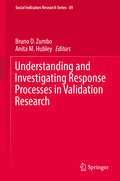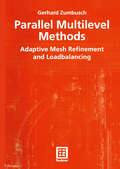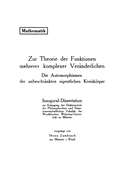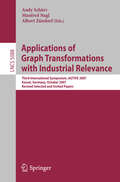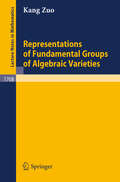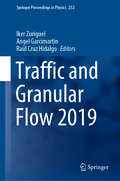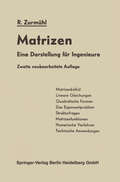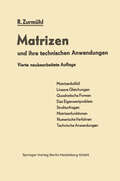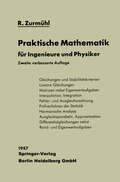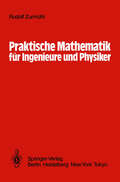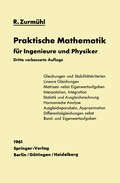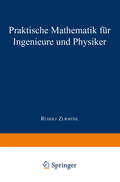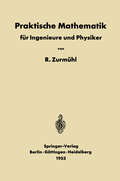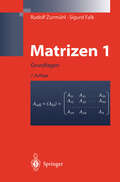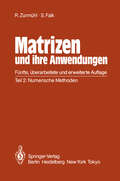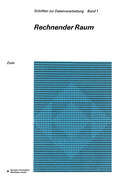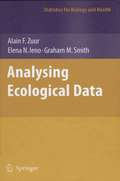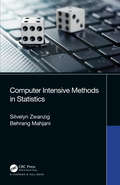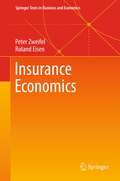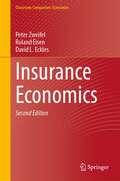- Table View
- List View
Understanding and Investigating Response Processes in Validation Research (Social Indicators Research Series #69)
by Bruno D. Zumbo Anita M. HubleyThis volume addresses an urgent need across multiple disciplines to broaden our understanding and use of response processes evidence of test validity. It builds on the themes and findings of the volume Validity and Validation in Social, Behavioral, and Health Sciences (Zumbo & Chan, 2014), with a focus on measurement validity evidence based on response processes. Approximately 1000 studies are published each year examining the validity of inferences made from tests and measures in the social, behavioural, and health sciences. The widely accepted Standards for Educational and Psychological Testing (1999, 2014) present five sources of evidence for validity: content-related, response processes, internal structure, relationships with other variables, and consequences of testing. Many studies focus on internal structure and relationships with other variables sources of evidence, which have a long history in validation research, known methodologies, and numerous exemplars in the literature. Far less is understood by test users and researchers conducting validation work about how to think about and apply new and emerging sources of validity evidence. This groundbreaking volume is the first to present conceptual models of response processes, methodological issues that arise in gathering response processes evidence, as well as applications and exemplars for providing response processes evidence in validation work.
Parallel Multilevel Methods: Adaptive Mesh Refinement and Loadbalancing (Advances in Numerical Mathematics)
by Gerhard ZumbuschMain aspects of the efficient treatment of partial differential equations are discretisation, multilevel/multigrid solution and parallelisation. These distinct topics are covered from the historical background to modern developments. It is demonstrated how the ingredients can be put together to give an adaptive and parallel multilevel approach for the solution of elliptic boundary value problems. Error estimators and adaptive grid refinement techniques for ordinary and for sparse grid discretisations are presented. Different types of additive and multiplicative multilevel solvers are discussed with respect to parallel implementation and application to adaptive refined grids. Efficiency issues are treated both for the sequential multilevel methods and for the parallel version by hash table storage techniques. Finally, space-filling curve enumeration for parallel load balancing and processor cache efficiency are discussed.
Zur Theorie der Funktionen mehrerer komplexer Veränderlichen: Die Automorphismen der unbeschränkten eigentlichen Kreiskörper
by Heinz ZumbuschDieser Buchtitel ist Teil des Digitalisierungsprojekts Springer Book Archives mit Publikationen, die seit den Anfängen des Verlags von 1842 erschienen sind. Der Verlag stellt mit diesem Archiv Quellen für die historische wie auch die disziplingeschichtliche Forschung zur Verfügung, die jeweils im historischen Kontext betrachtet werden müssen. Dieser Titel erschien in der Zeit vor 1945 und wird daher in seiner zeittypischen politisch-ideologischen Ausrichtung vom Verlag nicht beworben.
Applications of Graph Transformations with Industrial Relevance: Third International Symposium, AGTIVE 2007, Kassel, Germany, October 10-12, 2007, Revised Selected and Invited Papers (Lecture Notes in Computer Science #5088)
by Albert Zündorf Andy Schürr Manfred NaglThis book constitutes the thoroughly refereed post-conference proceedings of the Third International Symposium on Applications of Graph Transformations, AGTIVE 2007, held in Kassel, Germany, in October 2007. The 30 revised full papers presented together with 2 invited papers were carefully selected from numerous submissions during two rounds of reviewing and improvement. The papers are organized in topical sections on graph transformation applications, meta-modeling and domain-specific language, new graph transformation approaches, program transformation applications, dynamic system modeling, model driven software development applications, queries, views, and model transformations, as well as new pattern matching and rewriting concepts. The volume moreover contains 4 papers resulting from the adjacent graph transformation tool contest and concludes with 9 papers summarizing the state of the art of today's available graph transformation environments.
Pseudodifferential Equations Over Non-Archimedean Spaces (Lecture Notes in Mathematics #2174)
by W. A. Zúñiga-GalindoFocusing on p-adic and adelic analogues of pseudodifferential equations, this monograph presents a very general theory of parabolic-type equations and their Markov processes motivated by their connection with models of complex hierarchic systems. The Gelfand-Shilov method for constructing fundamental solutions using local zeta functions is developed in a p-adic setting and several particular equations are studied, such as the p-adic analogues of the Klein-Gordon equation. Pseudodifferential equations for complex-valued functions on non-Archimedean local fields are central to contemporary harmonic analysis and mathematical physics and their theory reveals a deep connection with probability and number theory. The results of this book extend and complement the material presented by Vladimirov, Volovich and Zelenov (1994) and Kochubei (2001), which emphasize spectral theory and evolution equations in a single variable, and Albeverio, Khrennikov and Shelkovich (2010), which deals mainly with the theory and applications of p-adic wavelets.
Representations of Fundamental Groups of Algebraic Varieties (Lecture Notes in Mathematics #1708)
by Kang ZuoUsing harmonic maps, non-linear PDE and techniques from algebraic geometry this book enables the reader to study the relation between fundamental groups and algebraic geometry invariants of algebraic varieties. The reader should have a basic knowledge of algebraic geometry and non-linear analysis. This book can form the basis for graduate level seminars in the area of topology of algebraic varieties. It also contains present new techniques for researchers working in this area.
Traffic and Granular Flow 2019 (Springer Proceedings in Physics #252)
by Iker Zuriguel Angel Garcimartín Raúl Cruz HidalgoThis book gathers contributions on a variety of flowing collective systems. While primarily focusing on pedestrian dynamics, they also reflect the latest developments in areas such as vehicular traffic and granular flows and address related emerging topics such as self-propelled particles, data transport, swarm behavior, intercellular transport, and collective dynamics of biological systems. Combining fundamental research and practical applications in the various fields discussed, the book offers a valuable asset for researchers and practitioners alike.
Praktische Mathematik: für Ingenieure und Physiker
by Rudolf ZurmühlDas Buch ist gedacht als eine Ergänzung und Fortführung der mathematischen Grundlagenvorlesung der Technischen Hochschule. Es möchte den jungen Ingenieurstudenten zu einer über diese Vorlesung hinausgehenden Beschäftigung mit jenem Zweig der Mathematik an regen, der für die zahlenmäßige Behandlung von Ingenieuraufgaben aller Art grundlegend ist: mit den numerischen V erfahren der praktischen Mathematik. In diese Methoden, ihre Theorie und ihre praktische Hand habung führt es ein, wobei gleicher Wert auf klare Entwicklung der theoretischen Grundgedanken wie auf Einzelheiten der Zahlen rechnung gelegt wird. Aber auch dem in der Praxis tätigen Ingenieur möchte das Buch eine Hilfe sein, wenn er bei der Durchführung seiner Aufgaben vorder Notwendigkeit steht, auf numerische V erfahren zurück zugreifen. Ein Buch, das sich an Ingenieure und Physiker wendet, muß in mancher Hinsicht anders abgefaßt sein als ein für Mathematiker be stimmtes. Es soll gewiß nicht weniger zuverlässig und einwandfrei sein. Aber während der Mathematiker in die Lage versetzt werden soll, selbst aktiv an der Entwicklung neuer Methoden mitzuarbeiten, sollen Physi ker und Ingenieur in erster Linie die praktische Handhabung der Metho den erlernen, um sie als Hilfsmittel für ihre eigentliche Berufsarbeit anzuwenden. Damit sie das sinnvoll und richtig können, müssen sie freilich die mathematischen Grundlagen eines Verfahrens voll verstan den haben. Mit einer bloßen Rezeptsammlung ist auch ihnen durchaus nicht gedient.
Praktische Mathematik für Ingenieure und Physiker
by Rudolf Zurmühl426 man fordert also Anfangs- und Endordinate der Lösung y (x) im Inter vall (a, b), Abb. 112. An Stelle der Randordinaten (sogenannte erste Randwertaufgabe) lassen sich auch die Randsteigungen y' (a), y' (b) . Y fordern (zweite Randwertaufgabe) oder schließ lich eine Linearkombination zwischen Ordinaten und Steigungen (dritte Randwertaufgabe). Alle jl diese Aufgaben oder auch ihre Kombinationen treten in den Anwendungen auf. . :c Ähnlich wie bei der Anfangswertaufgabe wird Abb. 112 Zur Randwertaufgabe man bei formelmäßiger Lösung versuchen, die in der allgemeinen Lösung enthaltenen freien Integratlonskonstanten aus den beiden Randbedingungen zu bestimmen und so die fragliche Sonderlösung y(x) festzulegen. Prinzipiell scheint sich gegenüber der Anfangswertaufgabe damit kaum etwas geändert zu haben. Bei der Durchführung derartiger Aufgaben aber zeigt sich sehr bald, daß sie im Gegensatz zur Anfangswertaufgabe nicht mehr in jedem Falle lösbar sind. Es treten hier also neue charakteristische Schwierigkeiten auf, zu deren Überwindung besondere Überlegungen notwendig werden. Aber auch die Behandlungsmethoden, insbesondere die uns vornehmlich interessierenden Näherungsverfahren, sind von denen der Anfangswertaufgaben grundverschieden, so daß wir es hier in der Tat mit einem neuen und im übrigen höchst reizvollen Gebiet der praktischen Mathematik zu tun haben, bei dem auch theoretische Fragen mehr als bisher in den Vordergrund treten werden. Die charakteristische Schwierigkeit des Randwertproblems sei an folgendem einfachen Beispiel erläutert. 1. Beispiel: Gegeben sei die - lineare - Differentialgleichung y" + y = 0 mit den Randbedingungen y(O) = 1, y(2) = O.
Matrizen und ihre Anwendungen 1: Grundlagen Für Ingenieure, Physiker und Angewandte Mathematiker (Klassiker der Technik #30)
by Rudolf Zurmühl Sigurd FalkDas Buch behandelt Matrizengleichungen und -funktionen sowie die computergerechte Darstellung und Lösung der Bewegungsgleichungen von Schwingungssystemen mit endlich vielen Freiheitsgraden und führt in die Grundlagen der Näherungsmethoden von Rayleigh und Ritz ein. Das Eigenwertproblem wird, anders als sonst üblich, von einem allgemeinen Standpunkt aus betrachtet. Dadurch gewinnt die Darstellung an Verständlichkeit und an Anwendungsbreite. Das Buch ist sowohl für Studierende als auch für Physiker und Ingenieure in der Praxis geschrieben.
Matrizen und ihre Anwendungen für Angewandte Mathematiker, Physiker und Ingenieure: Teil 2: Numerische Methoden
by Rudolf Zurmühl Sigurd FalkRechnender Raum (Schriften zur Datenverarbeitung)
by Konrad ZuseEs ist uns heute selbstverständlich, daß numerische Rechenverfahren erfolgreich ein gesetzt werden können, um physikalische Zusammenhänge zu durchleuchten. Dabei haben wir entsprechend Bild 1 eine mehr oder weniger enge Verflechtung zwischen Mathematikern, Physikern und den Fachleuten der Informationsverarbeitung. Die mathematischen Lehrgebäude dienen dem Aufbau physikalischer Modelle, deren numerische Durchrechnung heute mit elektronischen Datenverarbeitungsanlagen er folgt. Die Aufgabe der Fachleute der Informationsverarbeitung besteht im wesentlichen darin, für die von den Mathematikern und Physikern entwickelten Modelle möglichst brauchbare numerische Lösungen zu finden. Ein rückwirkender'Einfluß der Daten verarbeitung auf die Modelle und die physikalische Theorie selbst besteht lediglich indirekt in der bevorzugten Anwendung solcher Methoden, die der numerischen Lö sung besonders leicht zugänglich sind. Das enge Zusammenspiel zwischen Mathematikern und Physikern hat sich sehr günstig in bezug auf die Entwicklung der Modelle theoretischer Physik ausgewirkt. Das mo derne Gebäude der Quantentheorie ist weitgehend reine bzw. angewandte Mathematik. Es scheint daher die Frage berechtigt, ob die Informationsverarbeitung bei diesem Zusammenspiel nur eine ausführende Rolle spielen kann, oder ob auch von dort be fruchtende Ideen gegeben werden können, welche die physikalischen Theorien selbst rückwirkend beeinflussen. Diese Frage ist umso berechtigter, als sich in enger Zusam menarbeit mit der Informationsverarbeitung ein neuer Zweig der Wissenschaft ent wickelt hat, nämlich die Automatentheorie. Im folgenden werden einige Ideen in dieser Richtung entwickelt. Dabei kann keinerlei Anspruch auf Vollständigkeit in der Behandlung des Themas erhoben werden.
Analyzing Ecological Data (Statistics for Biology and Health)
by Alain Zuur Elena N. Ieno Graham M. SmithThis book provides a practical introduction to analyzing ecological data using real data sets. The first part gives a largely non-mathematical introduction to data exploration, univariate methods (including GAM and mixed modeling techniques), multivariate analysis, time series analysis, and spatial statistics. The second part provides 17 case studies. The case studies include topics ranging from terrestrial ecology to marine biology and can be used as a template for a reader’s own data analysis. Data from all case studies are available from www.highstat.com. Guidance on software is provided in the book.
Nanostructured Soft Matter: Experiment, Theory, Simulation and Perspectives (NanoScience and Technology)
by A. V. ZvelindovskyThis book provides an interdisciplinary overview of a new and broad class of materials under the unifying name Nanostructured Soft Matter. It covers materials ranging from short amphiphilic molecules to block copolymers, proteins, colloids and their composites, microemulsions and bio-inspired systems such as vesicles.
Computer Intensive Methods in Statistics
by Silvelyn Zwanzig Behrang MahjaniThis textbook gives an overview of statistical methods that have been developed during the last years due to increasing computer use, including random number generators, Monte Carlo methods, Markov Chain Monte Carlo (MCMC) methods, Bootstrap, EM algorithms, SIMEX, variable selection, density estimators, kernel estimators, orthogonal and local polynomial estimators, wavelet estimators, splines, and model assessment. Computer Intensive Methods in Statistics is written for students at graduate level, but can also be used by practitioners. Features Presents the main ideas of computer-intensive statistical methods Gives the algorithms for all the methods Uses various plots and illustrations for explaining the main ideas Features the theoretical backgrounds of the main methods. Includes R codes for the methods and examples Silvelyn Zwanzig is an Associate Professor for Mathematical Statistics at Uppsala University. She studied Mathematics at the Humboldt- University in Berlin. Before coming to Sweden, she was Assistant Professor at the University of Hamburg in Germany. She received her Ph.D. in Mathematics at the Academy of Sciences of the GDR. Since 1991, she has taught Statistics for undergraduate and graduate students. Her research interests have moved from theoretical statistics to computer intensive statistics. Behrang Mahjani is a postdoctoral fellow with a Ph.D. in Scientific Computing with a focus on Computational Statistics, from Uppsala University, Sweden. He joined the Seaver Autism Center for Research and Treatment at the Icahn School of Medicine at Mount Sinai, New York, in September 2017 and was formerly a postdoctoral fellow at the Karolinska Institutet, Stockholm, Sweden. His research is focused on solving large-scale problems through statistical and computational methods.
Computer Intensive Methods in Statistics
by Silvelyn Zwanzig Behrang MahjaniThis textbook gives an overview of statistical methods that have been developed during the last years due to increasing computer use, including random number generators, Monte Carlo methods, Markov Chain Monte Carlo (MCMC) methods, Bootstrap, EM algorithms, SIMEX, variable selection, density estimators, kernel estimators, orthogonal and local polynomial estimators, wavelet estimators, splines, and model assessment. Computer Intensive Methods in Statistics is written for students at graduate level, but can also be used by practitioners. Features Presents the main ideas of computer-intensive statistical methods Gives the algorithms for all the methods Uses various plots and illustrations for explaining the main ideas Features the theoretical backgrounds of the main methods. Includes R codes for the methods and examples Silvelyn Zwanzig is an Associate Professor for Mathematical Statistics at Uppsala University. She studied Mathematics at the Humboldt- University in Berlin. Before coming to Sweden, she was Assistant Professor at the University of Hamburg in Germany. She received her Ph.D. in Mathematics at the Academy of Sciences of the GDR. Since 1991, she has taught Statistics for undergraduate and graduate students. Her research interests have moved from theoretical statistics to computer intensive statistics. Behrang Mahjani is a postdoctoral fellow with a Ph.D. in Scientific Computing with a focus on Computational Statistics, from Uppsala University, Sweden. He joined the Seaver Autism Center for Research and Treatment at the Icahn School of Medicine at Mount Sinai, New York, in September 2017 and was formerly a postdoctoral fellow at the Karolinska Institutet, Stockholm, Sweden. His research is focused on solving large-scale problems through statistical and computational methods.
Insurance Economics (Springer Texts in Business and Economics)
by Peter Zweifel Roland Eisen"Winner of the 2014 Kulp-Wright Book Award Presented by the American Risk and Insurance Association".More information can be found here:http://www.aria.org/awards/bookawards.htm Insurance Economics brings together the economic analysis of decision making under risk, risk management and demand for insurance by individuals and corporations, objectives pursued and management tools used by insurance companies, the regulation of insurance, and the division of labor between private and social insurance. Appropriete both for advanced undergraduate and graduate students of economics, management, and finance, this text provides the background required to understand current research. Predictions derived from theoretical argument are not only stated but confronted with empirical evidence. Throughout the book, conclusions summarize results, helping readers to check their knowledge and understanding. Issues discussed include paradoxa in decision making under risk, selection of favorable risks by insurers, the possibility of a "death spiral" in insurance markets, and future challenges such as re-regulation in the wake of the 2007-09 financial crisis and the increasing availability of generic information.
Insurance Economics (Classroom Companion: Economics)
by Peter Zweifel Roland Eisen David L. EcklesInsurance Economics brings together the economic analysis of decision making under risk, risk management and demand for insurance among individuals and corporations, objectives pursued and management tools used by insurance companies, the regulation of insurance, and the division of labor between private and social insurance.Appropriate both for advanced undergraduate and graduate students of economics, management, and finance, this text provides the background required to understand current research. Predictions derived from theoretical arguments are not merely stated, but also related to empirical evidence. Throughout the book, conclusions summarize key results, helping readers to check their knowledge and comprehension. Issues discussed include paradoxes in decision making under risk and attempts at their resolution, moral hazard and adverse selection including the possibility of a “death spiral”, and future challenges to both private and social insurance such as globalization and the availability of genetic information. This second edition has been extensively revised. Most importantly, substantial content has been added to represent the evolution of risk-related research. A new chapter, Insurance Demand II: Nontraditional Approaches, provides a timely addition in view of recent developments in risk theory and insurance. Previous discussions of Enterprise Risk Management, long-term care insurance, adverse selection, and moral hazard have all been updated. In an effort to expand the global reach of the text, evidence and research from the U.S. and China have also been added.
